 I picked up two nucs (nucleus hives) this afternoon to expand our apiary (bee yard). I loaded them both with some extra tag-alongs into my trunk (which is why I kept my bee suit on). If you want to get some weird look, just ride around in town with a bee suit on.
I picked up two nucs (nucleus hives) this afternoon to expand our apiary (bee yard). I loaded them both with some extra tag-alongs into my trunk (which is why I kept my bee suit on). If you want to get some weird look, just ride around in town with a bee suit on.
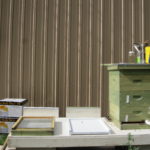 We started two hives last year, because we read that the survival rate for first year bee keepers is 50%. True to form, we lost one hive this spring. They were alive and flying some of the days in February, but they didn’t have enough stores to make it through the last cold snap at the beginning of March. It was the smaller hive that we picked up last May, so that makes sense. They also didn’t expand as much as the other hive throughout the year.
We started two hives last year, because we read that the survival rate for first year bee keepers is 50%. True to form, we lost one hive this spring. They were alive and flying some of the days in February, but they didn’t have enough stores to make it through the last cold snap at the beginning of March. It was the smaller hive that we picked up last May, so that makes sense. They also didn’t expand as much as the other hive throughout the year. 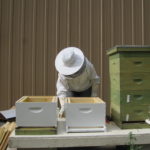 The other hive is going strong. We opened them up today and saw lots of maturing brood, so their numbers should be growing a lot in the days to come. For that reason, we went ahead and added a honey super, so they have plenty of room to grow into. You can see that we added a queen excluder (about an inch wide) to the green hive, just above the third hive body, so that the queen won’t lay eggs in the top (fourth) box, and we can harvest honey from it this year! (very exciting!)
The other hive is going strong. We opened them up today and saw lots of maturing brood, so their numbers should be growing a lot in the days to come. For that reason, we went ahead and added a honey super, so they have plenty of room to grow into. You can see that we added a queen excluder (about an inch wide) to the green hive, just above the third hive body, so that the queen won’t lay eggs in the top (fourth) box, and we can harvest honey from it this year! (very exciting!)
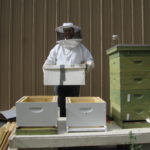
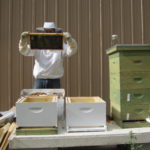 The nucs were driven from Florida yesterday, but they made it safe and sound. I prefer to buy bees raised locally which we did last year, but since my hive died so late in the winter, there weren’t any opportunities for that. It is extremely hard to find bees for sale as late as March. You really need to order bees in January. I also opted to buy nucs instead of bee packages to give them a head start. A bee package comes with a set weight of bees and a queen. They have to start from scratch, building out the comb before they can start laying eggs and expanding the hive. A nuc comes as a small hive, including frames with comb built out on them, eggs and brood, and some honey. As I unpacked the nucs, I checked each frame for the queen, just to put my mind at ease. I did see her in the second nuc but didn’t spot her in the first. I’m not too concerned, though, because there were lots of newly laid eggs in both.
The nucs were driven from Florida yesterday, but they made it safe and sound. I prefer to buy bees raised locally which we did last year, but since my hive died so late in the winter, there weren’t any opportunities for that. It is extremely hard to find bees for sale as late as March. You really need to order bees in January. I also opted to buy nucs instead of bee packages to give them a head start. A bee package comes with a set weight of bees and a queen. They have to start from scratch, building out the comb before they can start laying eggs and expanding the hive. A nuc comes as a small hive, including frames with comb built out on them, eggs and brood, and some honey. As I unpacked the nucs, I checked each frame for the queen, just to put my mind at ease. I did see her in the second nuc but didn’t spot her in the first. I’m not too concerned, though, because there were lots of newly laid eggs in both.
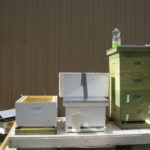 We installed both nucs, then put some hive beetle traps. They fit in-between the frames and are filled with vegetable oil. The bees can’t fit through the holes of the trap, but they chase the hive beetles through them, where they drown in the oil.
We installed both nucs, then put some hive beetle traps. They fit in-between the frames and are filled with vegetable oil. The bees can’t fit through the holes of the trap, but they chase the hive beetles through them, where they drown in the oil.
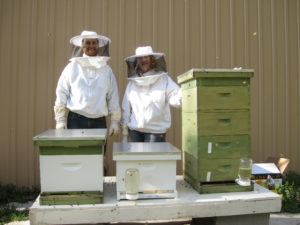 It was a great day to install the bees. They took to the new hives, and we’ll be monitoring their progress with anticipation! Thanks to my Mom for all the help!
It was a great day to install the bees. They took to the new hives, and we’ll be monitoring their progress with anticipation! Thanks to my Mom for all the help!
If you need help setting up a new hive, we can help on choosing hive placement, provide an equipment purchase list, and supply training and nuc/package installation assistance. Go to the Regenerative Landscaping Services Page for more info.
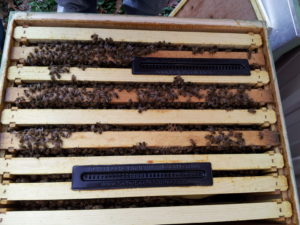 Last week, we winterized our bees for their second winter. There are two main components that we we added to the hives to help them get through the winter.
Last week, we winterized our bees for their second winter. There are two main components that we we added to the hives to help them get through the winter.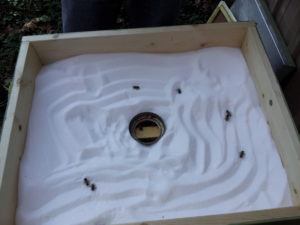
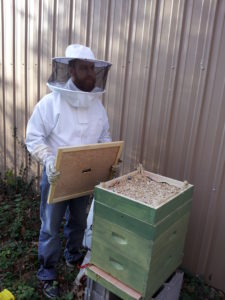
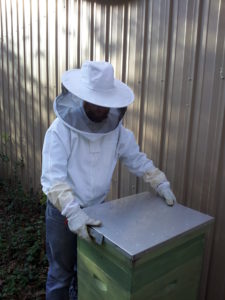
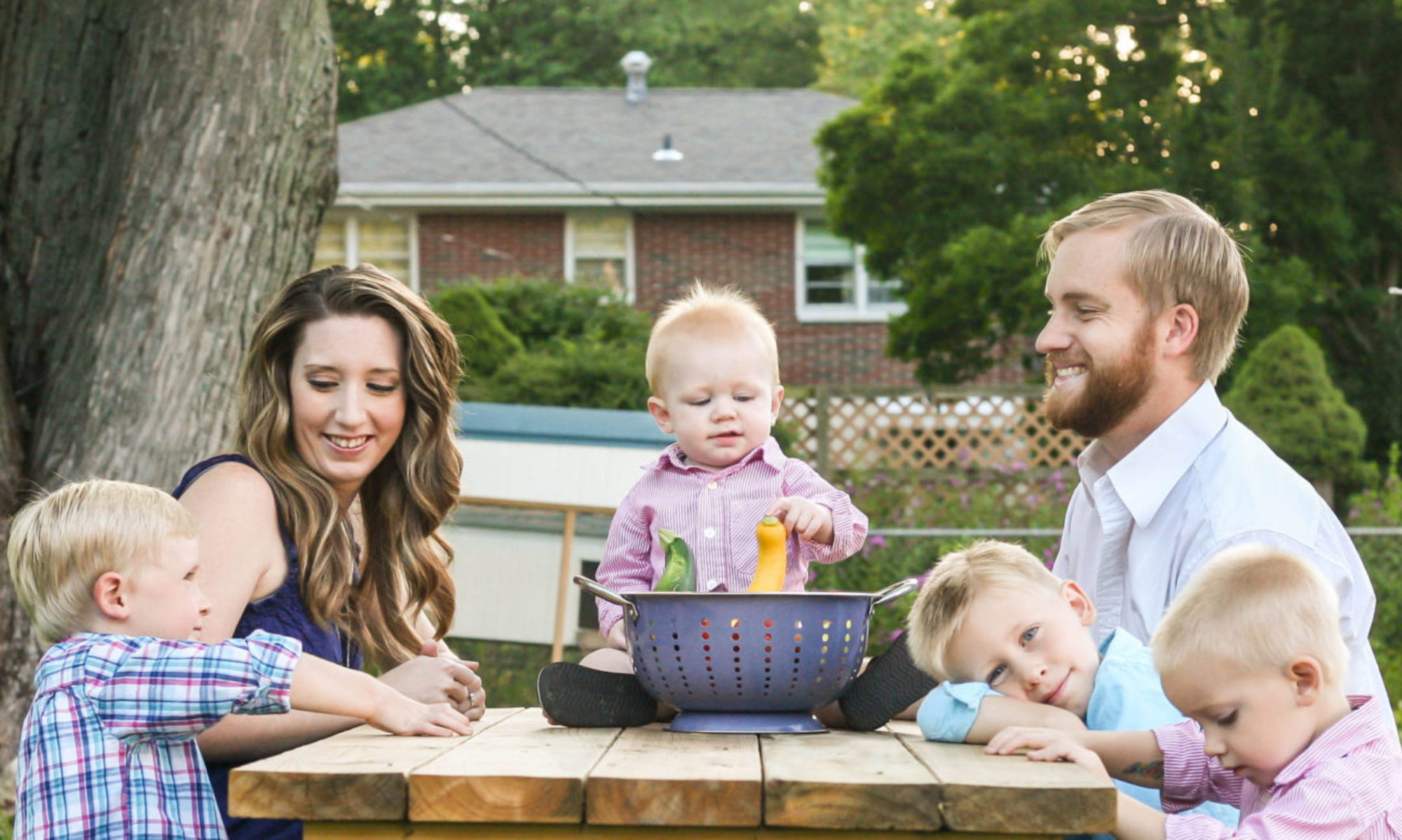
 I picked up two nucs (nucleus hives) this afternoon to expand our apiary (bee yard). I loaded them both with some extra tag-alongs into my trunk (which is why I kept my bee suit on). If you want to get some weird look, just ride around in town with a bee suit on.
I picked up two nucs (nucleus hives) this afternoon to expand our apiary (bee yard). I loaded them both with some extra tag-alongs into my trunk (which is why I kept my bee suit on). If you want to get some weird look, just ride around in town with a bee suit on. We started two hives last year, because we read that the survival rate for first year bee keepers is 50%. True to form, we lost one hive this spring. They were alive and flying some of the days in February, but they didn’t have enough stores to make it through the last cold snap at the beginning of March. It was the smaller hive that we picked up last May, so that makes sense. They also didn’t expand as much as the other hive throughout the year.
We started two hives last year, because we read that the survival rate for first year bee keepers is 50%. True to form, we lost one hive this spring. They were alive and flying some of the days in February, but they didn’t have enough stores to make it through the last cold snap at the beginning of March. It was the smaller hive that we picked up last May, so that makes sense. They also didn’t expand as much as the other hive throughout the year.  The other hive is going strong. We opened them up today and saw lots of maturing brood, so their numbers should be growing a lot in the days to come. For that reason, we went ahead and added a honey super, so they have plenty of room to grow into. You can see that we added a queen excluder (about an inch wide) to the green hive, just above the third hive body, so that the queen won’t lay eggs in the top (fourth) box, and we can harvest honey from it this year! (very exciting!)
The other hive is going strong. We opened them up today and saw lots of maturing brood, so their numbers should be growing a lot in the days to come. For that reason, we went ahead and added a honey super, so they have plenty of room to grow into. You can see that we added a queen excluder (about an inch wide) to the green hive, just above the third hive body, so that the queen won’t lay eggs in the top (fourth) box, and we can harvest honey from it this year! (very exciting!)
 The nucs were driven from Florida yesterday, but they made it safe and sound. I prefer to buy bees raised locally which we did last year, but since my hive died so late in the winter, there weren’t any opportunities for that. It is extremely hard to find bees for sale as late as March. You really need to order bees in January. I also opted to buy nucs instead of bee packages to give them a head start. A bee package comes with a set weight of bees and a queen. They have to start from scratch, building out the comb before they can start laying eggs and expanding the hive. A nuc comes as a small hive, including frames with comb built out on them, eggs and brood, and some honey. As I unpacked the nucs, I checked each frame for the queen, just to put my mind at ease. I did see her in the second nuc but didn’t spot her in the first. I’m not too concerned, though, because there were lots of newly laid eggs in both.
The nucs were driven from Florida yesterday, but they made it safe and sound. I prefer to buy bees raised locally which we did last year, but since my hive died so late in the winter, there weren’t any opportunities for that. It is extremely hard to find bees for sale as late as March. You really need to order bees in January. I also opted to buy nucs instead of bee packages to give them a head start. A bee package comes with a set weight of bees and a queen. They have to start from scratch, building out the comb before they can start laying eggs and expanding the hive. A nuc comes as a small hive, including frames with comb built out on them, eggs and brood, and some honey. As I unpacked the nucs, I checked each frame for the queen, just to put my mind at ease. I did see her in the second nuc but didn’t spot her in the first. I’m not too concerned, though, because there were lots of newly laid eggs in both. We installed both nucs, then put some hive beetle traps. They fit in-between the frames and are filled with vegetable oil. The bees can’t fit through the holes of the trap, but they chase the hive beetles through them, where they drown in the oil.
We installed both nucs, then put some hive beetle traps. They fit in-between the frames and are filled with vegetable oil. The bees can’t fit through the holes of the trap, but they chase the hive beetles through them, where they drown in the oil. It was a great day to install the bees. They took to the new hives, and we’ll be monitoring their progress with anticipation! Thanks to my Mom for all the help!
It was a great day to install the bees. They took to the new hives, and we’ll be monitoring their progress with anticipation! Thanks to my Mom for all the help!